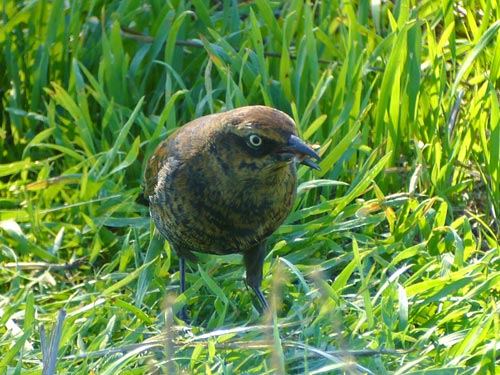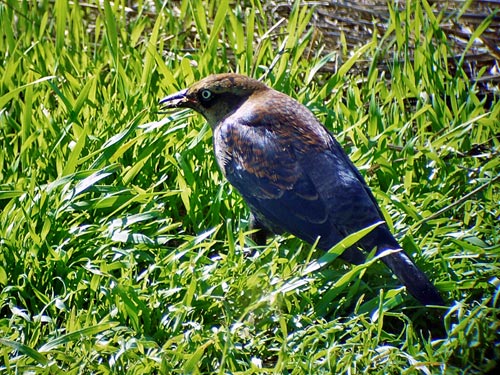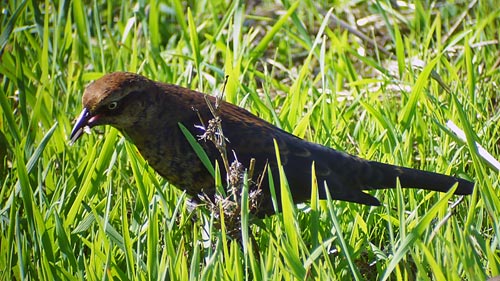Rusty Blackbird (Euphagus
carolinus)
Coyote Point, San Mateo, San Mateo County, California
15 November 2008
Joseph Morlan
Photos © 15 November 2008 by Joseph Morlan. All rights reserved. Larger
images have been posted here (click on "full size").
 Today I was
finishing up leading my Ornithology class field trip near the Coyote Point Yacht Harbor. We visited the fresh water
marsh just southeast of the yacht club to look for Wilson's Snipe and other marsh species. One of my students drew
my attention to a female Brewer's Blackbird. While watching the blackbird, I was shocked to see a bright Rusty
Blackbird walk behind the small blackbird flock. I checked the rusty tertial fringes (see photo below) to ensure
that the bird was not the uncommon rusty morph of the Brewer's Blackbird (Euphagus cyanocephalus) and confirmed
the identification as a Rusty Blackbird.
Today I was
finishing up leading my Ornithology class field trip near the Coyote Point Yacht Harbor. We visited the fresh water
marsh just southeast of the yacht club to look for Wilson's Snipe and other marsh species. One of my students drew
my attention to a female Brewer's Blackbird. While watching the blackbird, I was shocked to see a bright Rusty
Blackbird walk behind the small blackbird flock. I checked the rusty tertial fringes (see photo below) to ensure
that the bird was not the uncommon rusty morph of the Brewer's Blackbird (Euphagus cyanocephalus) and confirmed
the identification as a Rusty Blackbird.
After confirming the identification and making sure that all the students got on the bird I attempted to photograph
it by hand holding my Panasonic LZ5 up to the the 30X WA eyepiece of my Nikon Fieldscope III. Several of the images
came out and three of them are posted here. Times from the EXIF photo information indicate the photos were taken
between 11:53 am and 12:07pm. The bird was well studied by everyone in my class. A partial list follows:
Natalee Ernstrom, Angie Geiger, James Lansing, Joel Goldman, John Johnson, Kevin Liberg, Dale Ahearn, Nicole
Brodsky, Juin-Ren Chen, Laura Cleveland, Skip Getz, Leslie Lopato, Janine Watson, Judy Reynolds and Stacy Hanes.
Description
The following description is based on memory and on verbal notes which I made while watching the bird. The verbal
notes were kindly transcribed by Natalee Ernstrom.
A medium blackbird, perhaps slightly larger than adjacent Brewer's Blackbirds. Compared to the Brewer's Blackbirds
the bill was longer and thinner with a straighter culmen (see photo below right). Also the forehead was flatter
lacking the steep angle typical of Brewer's Blackbird. The crown and upper back were a bright copper bronze color,
depending on the light, and it was this mantle color that made the bird stand out as it foraged in the tall grass.
The eye was very pale, almost white and was set off by a blackish mask. The underparts were mostly pale brown,
heavily mottled and barred with slaty-black.
The back and scapular feathers were deep copper or bronze with dark gray fringing, forming a mottled appearance.
The lower back was slaty-gray. The wing coverts were dark slate-gray or blackish depending on the light. The tertials
and greater coverts had narrow rusty-brown fringes. The tail was all dark blackish.
The legs and feet were dark.
The bird walked on the ground, bobbing its head in a manner similar to other blackbirds. It seemed to be
holding its bill open all the time, possibly in reaction the heat. It was a very warm morning. 
Discussion
Rusty Blackbirds have been declining seriously in the East throughout their normal range. The cause of this
decline is unknown. Partly because of this decline, the species was added to the California Bird Records Committee
Review list in January 2006. Most California records are from late Fall and Winter.
Determining age and sex in the field is tricky. Pyle uses the pattern of the greater underwing coverts, but
these are seldom visible in the field. If the bird is an immature, it may be possible to sex it based on the pattern
of the back and underparts. On males there is much more dark showing through the rusty feather tips, and this is
the pattern seen in our bird. I believe if this bird were an adult male that it would probably show even more blackish
coloration on the underparts, but an immature might be expected to show broader rusty tertial fringes and possibly
duller eye color. My tentative conclusion is that it is a male, probably immature.
Previous Rusty Blackbird Records in San Mateo County
Special thanks to Ron Thorn for providing many of the early records
- 24 Nov-16 Dec 2005 - Menlo Park, Bayfront Park (photos)
- 22 Dec 1997 - Palo Alto, Jasper Ridge
- 28 Jan-13 Mar 1996 - Pescadero, Phipps Ranch
- 23-24 Oct 1994 Princeton, El Granada
- 28 Oct 1991 - Gazos Creek Beach Access
- 7 Jan-11 Feb 1990 - Pescadero, South Stage Road

- 18 Nov 1987-20 January 1988 - Half Moon Bay, Wavecrest Street
- 3 Jan-21 Mar1987 - Pescadero, North Street,
- 31 Oct 1985-1 Feb 1986 (2 individuals) - Pescadero, Cloverdale Road
- 24 Oct-3 Nov 1982 - San Gregorio State Beach ( first county record )
Selected References
Update
The bird was seen again the next morning, 16 November by Rich Ferrick and Ron Thorn. They relocated it further
to the south near the Harbor View Park baseball field. Further attempts to locate the bird have not been successful
thus far.
 Today I was
finishing up leading my Ornithology class field trip near the Coyote Point Yacht Harbor. We visited the fresh water
marsh just southeast of the yacht club to look for Wilson's Snipe and other marsh species. One of my students drew
my attention to a female Brewer's Blackbird. While watching the blackbird, I was shocked to see a bright Rusty
Blackbird walk behind the small blackbird flock. I checked the rusty tertial fringes (see photo below) to ensure
that the bird was not the uncommon rusty morph of the Brewer's Blackbird (Euphagus cyanocephalus) and confirmed
the identification as a Rusty Blackbird.
Today I was
finishing up leading my Ornithology class field trip near the Coyote Point Yacht Harbor. We visited the fresh water
marsh just southeast of the yacht club to look for Wilson's Snipe and other marsh species. One of my students drew
my attention to a female Brewer's Blackbird. While watching the blackbird, I was shocked to see a bright Rusty
Blackbird walk behind the small blackbird flock. I checked the rusty tertial fringes (see photo below) to ensure
that the bird was not the uncommon rusty morph of the Brewer's Blackbird (Euphagus cyanocephalus) and confirmed
the identification as a Rusty Blackbird.
